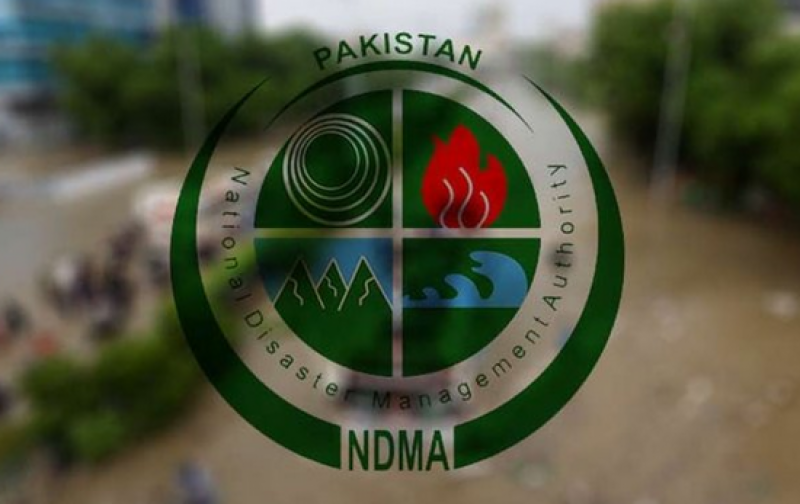Islamabad (Agencies): The National Disaster Management Authority (NDMA) on Friday advised all the relevant federal and provincial authorities to ensure preventive measures in the wake of forecast for pre-monsoon wind-thundershower with heavy falls causing risk of urban flooding and landslides in the north of country.
In its advisory, the NDMA said that the pre-monsoon rains with dust-thunderstorms were predicted from June 25-30 as an intruding weather system was bringing moist currents from the Arabian Sea which was penetrating upper and central parts of the country along with a westerly wave which was likely to enter upper parts on June 25.
“Under the influence of this weather system”, it said, “the Pakistan Meteorological Department (PMD) has predicted rain and wind-thundershowers with few heavy falls in Khyber Pakhtunkhwa (KP), Punjab, Gilgit-Baltistan, Azad Jammu & Kashmir (AJK) and Islamabad Capital Territory (ICT) from June 24 (night) to 30, and rain and wind-thundershowers with isolated heavy falls in Punjab, KP, Balochistan, and ICT from June 26 to 29. However, from June 27 to 28 rain and wind-thundershowers with isolated heavy falls are expected in Sindh.
The NDMA said in light of the above weather system forecast, “following impacts are expected in aforesaid parts of Pakistan: prevailing heatwave conditions are likely to subside, while heavy rainfall may cause urban flooding in low lying areas of Islamabad, Rawalpindi, Peshawar, Gujranwala and Lahore from June 26-27, and trigger landslides in the vulnerable areas of Murree, Galliyat and other hilly areas of KP, Gilgit Baltistan and AJK.”
Heavy rainfall might also cause flash flooding in the hill torrents of Dera Ghazi Khan, Rajanpur and adjoining areas of north-east Balochistan on June 27, it added.
Dust storms and wind-thunderstorms and heavy falls might cause damage to loose structures such as electrical poles, solar panels, hoardings, tall trees and under construction buildings, the NDMA warned.
“In the light of the above, all provincial, Gilgit Baltistan, and State Disaster Management Authorities (PDMAs, GBDMA and SDMA respectively) and ICT Administration, National Highway Authority, National Highway and Motorway Police, Frontier Works Organization (FWO) , Rescue 1122, line departments, ministries and federal agencies are required to undertake measures as per respective mandates,” the Authority directed.
It also directed the PMD, Flood Forecasting Division (FFD), PDMAs and PIDs to monitor water levels in rivers, streams, and urban drainage systems continuously to detect any signs of rising water and initiate early response measures.
The Authority directed to proactively maintain nullahs and storm water drains to ensure their proper functioning and prevent blockages that might lead to urban flooding, while drainage systems were clear of debris and obstacles to facilitate the efficient flow of water and minimize risk of urban flooding.
The NDMA also directed to ensure immediate stocking of basic commodities, including paramedics and medicines, especially in regions that were likely to get cut-off during landslides and avalanches flooding.
It added that activate early warning systems in flash flood-prone areas should promptly alert residents and facilitate their evacuation to safer locations.
The NDMA also directed the authorities to coordinate with relevant departments to secure loose structures such as electrical poles, solar panels, hoardings, and under-construction buildings to mitigate potential damages from dust-wind and thunderstorms.
The authorities were also asked to advise the general public to seek shelter in safe areas such as sturdy buildings or underground structures during dust-wind and thunderstorms, and avoid objects that pose a risk of falling and being struck by lightning.
It also demanded to conduct mass public awareness campaigns to educate residents in vulnerable areas about the risks of landslides, urban flooding, flash flooding and hill torrents, and take precautionary measures to forewarn travellers and visitors about risks posed at landslide, flash flood and hill torrents in vulnerable locations and provide guidance and assistance in case of emergencies through local administration, police and rescue services.
The NDMA underlined the need to advise farmers to take necessary mitigative and precautionary measures to safeguard their crops, such as timely harvesting, safe storage, or any other precautions from adverse effects of dust-wind-thunderstorms and hailstorms.


